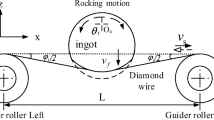Abstract
Multi-wire saw becomes the dominant method in slicing the hard brittle material into wafers. In this process, saw wire is the critical consumable and the dominant component of the wafer’s slicing cost. However, unreasonable process parameters lead to the fact that the saw wire was not fully used. This enormously increases the wire cost. For this reason, the constant wire wear loss model is presented by taking the free abrasive wire sawing as an example. This model takes the various cutting conditions into account and ensures the whole wire wear loss to reach the preset reasonable value. Firstly, a hypothesis that there is a mapping relation between the wire wear loss and the wire slicing area during the wire lifetime is built. According to this hypothesis, the wire allowed wear loss can be transformed into wire allowed slicing area. Secondly, the calculation method is deduced based on the model. The function relation is obtained between the wire feedback ratio and the actual slicing conditions under the constraint condition of the preset wire wear allowed loss. This rational feedback ratio of wire is obtained based on the actual process parameters. Thirdly, experiments are carried out. The results indicate that the relation between wire wear loss and wire slicing area is linear under the condition of the experiments and the wire consumption is reduced obviously. Meanwhile, wafers’ quality meets the requirements. This method can effectively save saw wire cost, referring to slicing other hard brittle materials by multi-wire saw.
Similar content being viewed by others
References
Bhagavat M, Prasad V, Kao I (2000) Elasto-hydrodynamic interaction in the free abrasive wafer slicing using a wiresaw: modeling and finite element analysis. J Tribol-T ASME 122:394–404
Wang Z, Miao J, Tan CW (2009) Acoustic transducers with a perforated damping backplate based on PZT/siliconwafer bonding technique. Sensor Actuat A Phys 149(2):277–283
Wei SB, Kao I (2000) Vibration analysis of wire and frequency response in modern wiresaw manufacturing process. J Sound Vib 231(5):1383–1395
Möeller HJ (2004) Basic mechanisms and models of multi-wire sawing. Adv Eng Mater 6(7):501–513
Ng TW, Nallathamby R (2004) Optical evaluation of ingot fixity in semiconductor wafer slicing. Opt Laser Technol 36:641–645
Pei ZJ, Xin XJ, Liu W (2003) Finite element analysis for grinding of wire-sawn silicon wafers: a designed experiment. Int J Mach Tool Manuf 43:7–16
Wang W, Liu ZX, Zhang YH, Allen DM (2011) Abrasive electrochemical multi-wire slicing of solar silicon ingots into wafers. CIRP Ann Manuf Technol 60:255–258
Qiu MB (2010) Research on electrical discharged machining of semiconductor crystal materials (in Chinese). Dissertation, Nanjing University of Aeronautics and Astronautics
Chang MR (2006) Study on quality control of linear running craftwork of si wafer (in Chinese). Semicon Technol 31(3):176–179
Goodrich A, Hacke P, Wang Q, Sopori B, Margolis R, James TL (2013) A wafer-based monocrystalline silicon photovoltaics road map: utilizing known technology improvement opportunities for further reductions in manufacturing costs. Sol Energy Mater Sol Cell 114:110–135
Hwang B, Park K, Kim HB, Kim KH, Bae DS, Cho YR (2012) Effect of tensile properties on the abrasive wear of steel saw wires used for silicon ingot slicing. Wear 290–291:94–98
Meißner D, Schoenfelder S, Hurka B, Zeh J, Sunder K et al (2014) Loss of wire tension in the wire web during the slurry based multi wire sawing process. Sol Energy Mater Sol Cell 120:346–355
Hsu CY, Chen CS, Tsao CC (2009) Free abrasive wire saw machining of ceramics. Int J Manuf Technol 40:503–511
Li Z, Cai YJ (2010) Experiment on saw mark of machining monocrystalline silicon (in Chinese). Int Conf Mech Autom Control Eng. doi:10.1109/MACE.2010.5535709
Guimaraes L, Santos R, Almada-Lobo B (2011) Scheduling wafer slicing by multi-wire saw manufacturing in photovoltaic industry: a case study. Int J Manuf Technol 53:1129–1139
Li BJ, Feng T (2009) A basic study on the relation between wire diameter and wafer warp (in Chinese). Eq Electron Prod Manuf 175:16–19
Chang CW, Wu CR, Lin CT, Chen HC (2008) Evaluating and controlling silicon wafer slicing quality using fuzzy analytical hierarchy and sensitivity analysis. Int J Manuf Technol 36:322–333
Author information
Authors and Affiliations
Corresponding author
Rights and permissions
About this article
Cite this article
Li, Z., Wang, M.J., Pan, X. et al. Slicing parameters optimizing and experiments based on constant wire wear loss model in multi-wire saw. Int J Adv Manuf Technol 81, 329–334 (2015). https://doi.org/10.1007/s00170-015-7229-5
Received:
Accepted:
Published:
Issue Date:
DOI: https://doi.org/10.1007/s00170-015-7229-5



